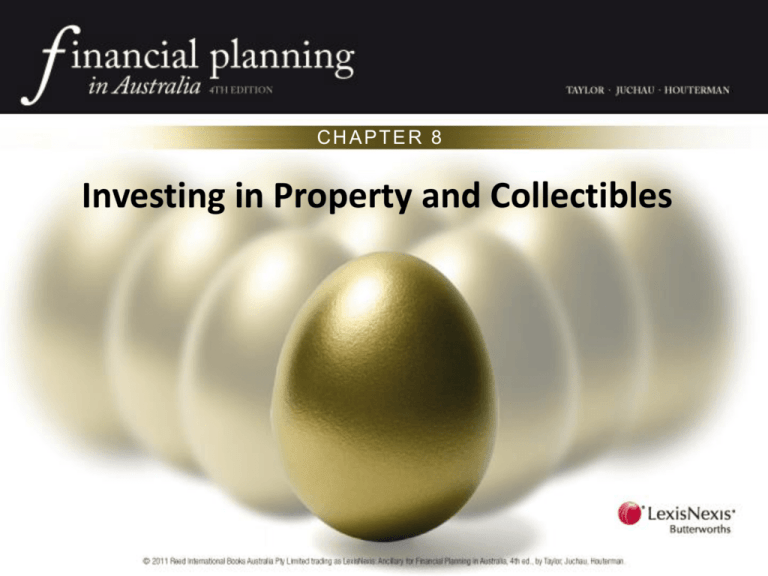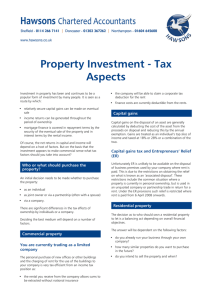Investing in Property and Collectables Powerpoint Lexis Nexis 2012
advertisement

CHAPTER 8 Investing in Property and Collectibles OVERVIEW • Tangible investments like property are attractive to many investors • The attraction increases in bad times when faith is lost in financial assets • Nevertheless, there are advantages and disadvantages to property investment • Careful evaluation is needed before investing • Gold, art and collectibles can also all act as medium- to long-term investments Advantages of property investment • Tax deductions are available for interest payments on loans and various property related expenses • Property provides an income stream and capital gains • Property can act to diversify and stabilise a portfolio • Residential property has historically been a stable asset class • Investment property can be a stepping stone to home ownership • Being tangible, you can see what you’re investing in Disadvantages of property investment • Property is heavily taxed; capital gains taxes, land tax, stamp duty, GST • Transaction costs are high; legal fees, agents fees, conveyancing costs • Medium to long term may be required to achieve a net capital gain • Commercial property involves complexity; zoning, planning, leasing • Property is illiquid • Expertise and research is required • Maintenance and management may be expensive and difficult Issues of Supply and Demand • The market for homes is subject to the same supply and demand pressures as any other market • However, the social and psychological issues involved in the housing market make it especially important • When we think of the property market we think of homes, units, rental investments, etc, but the real property market is the market for land, which is a limited commodity Residential Property Factors that may affect the demand for residential property include: • immigration levels • inflation • deferring of 1st home purchase • interest rates (as interest rates increase, rent increases as people less able to service mortgage commitments) • changes to various state and federal taxes and duties Commercial Property Includes industrial sites, offices, retail, and hotel or motel accommodation. Commercial property has traditionally been treated as a defensive asset class and yet has historically outperformed residential property. Commercial property requires significant expertise to deal with matters such as owning, planning and leases. Methods of property investment • Directly through a real estate agent by negotiated sale auction • Through listed or unlisted property trusts • Through a property syndicate Housing Affordability • State & federal taxes • Stamp duty — purchase duty & mortgage duty • GST (newly built homes) • Financial resources available • Household saving capacity • Repayment capacity Property taxes State taxes • Stamp duty; between $15,000 and $23,000 for a $460,000 purchase • Land tax; between 1% and 3.6% on values above thresholds from $360,000$2,299,000 (excluding the home). Federal taxes • GST; payable on commercial and new residential properties and sales commissions, but not on existing residential properties or on residential rental payments • CGT; exemption for the main residence and special rules for deceased estates Stamp Duty Stamp duty is a state tax levied on purchase of property, including main residence. It is charged on both the purchase and mortgage value in most states. Stamp Duty • The table below shows the different amounts of stamp duty payable (purchase duty only) on the purchase of a $460,000 home in 2010 by state: Victoria 22,670 South Australia 19,330 New South Wales 16,190 Queensland 14,525 Tasmania 15,950 Western Australia 15,865 Northern Territory 18,305 ACT 18,300 Land Tax • 31st December 2004 saw the scrapping of the land tax free threshold of $317,000 in NSW. An API survey found the tax was adversely affecting 93% of buyers and 79% of developers to buy in NSW (Sunday Telegraph May 1, 2005). • The land tax free threshold in NSW in 2010 is $376,000 and the tax rate is 1.6%. • A 2% surcharge applies on values above $2,299,000. GST • The purchase of new residential property and commercial premises is subject to 10% GST. No GST is charged on land or on the sale of existing residential property. • GST also applies to commissions from the sale of property and rental commissions but no GST is charged on the rent paid by a tenant for residential purposes. Capital Gains Tax Capital gains tax (CGT) applies to assets purchased after 20/9/1985, with 50% of the gain on property included as assessable income. CGT is covered in more detail in other chapters of the text but can be summarised as follows: • Main residence exemption (not available where owned by company or trust). • Charged on land adjacent to family home if sold separately. Capital Gains Tax • Charged on family home if person ceases to be Australian resident. • Charged on sale of investment property. • No CGT on deceased estates if continued to be used as main residence by successive generations or if disposed less than 2 years after deceased died. After this, the cost base is equal to market value at date of death of deceased if purchased prior to September 1985 or if main residence. Otherwise date of purchase used. CGT & Home office • It is important also to consider if a main residence is being used as a place of business, as the CGT exemption is reduced accordingly. • The ATO have made a distinction between a ‘place of business’ (eg doctor has consulting rooms attached to main residence) and a ‘place of convenience’ (eg teacher prepares lessons and marks at home). CGT & Home office • Deductibility for running costs (electricity, depreciation of office furnishings, computer depreciation, telephone) is allowable in both situations but deduction for occupancy costs (rent, mortgage, interest, insurance) is only allowed for a place of business. Also, the home owner must consider the additional cost of CGT that may be payable on the business portion of the sale of their main residence in the future. City v Country • While housing booms usually affect prime suburbs around capital cities the most, even in many rural centres there have been unprecedented price increases over recent years. • In some part, this reflects increased demand as more people wish to get out of the city. • Many people make the decision to move away from cities based on personal, rather than financial criteria. While they consider the lifestyle change positive, they may find that their new environment does not actually fit their social and personal needs. Property investment analysis When purchasing a property for investment purposes, it is important to ensure sufficient research has been conducted. The following points should be considered: 1. The investor’s objectives — risk, return and term. 2. The location — residential (close to schools, transport, shops) or commercial. 3. The property market — vacancy rates, type of tenant, recent selling prices and rental income of similar properties in the area. Property investment analysis 4. The condition of the property — does a building inspection reveal any costly repairs or maintenance requirements? Does the property conform to council regulations? Does the age of the property suggest any costly renovations will be required? Does the pest inspection reveal a problem with termites or other pests that might be costly to remove? 5. Income generation — rental income, lease term, vacancy rate. 6. Capital appreciation and applicable time frame. 7. Costs — transfer costs, operating costs, property management costs, loan payments. 8. Cash flow analysis — pre and post tax. Property investment analysis 9. The investor’s objectives — risk, return and term. 10. The location — residential (close to schools, transport, shops) or commercial. 11. The property market — vacancy rates, type of tenant, recent selling prices and rental income of similar properties in the area. Investing in Gold • • • • Aesthetic value and intrinsic worth History as coinage and store of value Underpinned currency for most of the twentieth century Renewed popularity post GFC Advantages of investing in gold • • • • • More liquid than other tangible investments A useful diversification instrument Increases in value at times of low interest rates Can hedge against inflation Demand for gold often increases in times of economic and political instability Drawbacks of investing in gold • • • • • Insurance costs Storage and handling security and costs No income stream (other than if invested in ETFs) Possible fraudulent activity Possible capital gains tax implications Ways to Invest in Gold • • • • Buy physical gold Buy gold mining stocks Buy gold ETFs Buy gold based derivatives Investing in Art • • • • Take pleasure from the investment Useful diversification $1,000 upwards minimum investment High returns but also underperformance and losses are possible Advantages of Investing in Art • • • • • • • • • Store of value for use as a medium- to long-term buy and hold investment strategy; Alternative investment class which moves counter cyclical to other major commodities; Opportunity for portfolio diversification; Inflation hedge in periods of high inflation Ease of entry to the market Investment from $1000 Potentially significant capital appreciation Possibility of receiving rental/lease income from galleries, businesses or restaurants Aesthetic appeal Drawbacks of Investing in Art • • • • • • • • Relatively illiquid Not usually divisible Need to keep adequately insured Risk of buying a ‘fake’, or of reattribution Strict rules for self-managed superannuation funds (SMSFs) Capital gains tax (CGT) implications for items acquired for more than $500 Transport, storage and restoration risks and costs Very high transaction costs Considerations when Investing in Art • • • • • • • Investment strategy — capital appreciation, income Investment term Genre, school or style Budget Expertise and research Method of purchasing Record keeping Investing in Other Collectibles • • • • • Any items that appeal to collectors that might be expected to increase in value over time May include antiques; jewellery; coins; bank notes; rare folios, manuscripts or books; postage stamps; collectors’ motor cars, motorbikes and boats; posters, comic books, toys, sporting memorabilia, movie memorabilia, musical instruments Detailed knowledge of the market is required Collectables are relatively illiquid; there are high costs in storage, insurance, transaction costs and capital gains tax. They may provide a hedge against inflation Summary • Tangible investments like property are attractive to many investors • The attraction increases in bad times when faith is lost in financial assets • Nevertheless, there are advantages and disadvantages to property investment • Careful evaluation is needed before investing • Gold, art and collectibles can also all act as medium- to long-term investments





